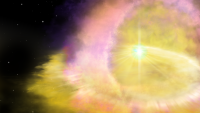Scientists discover supernova that outshines all others

A supernova which is at least twice as bright and energetic, and likely much more massive than any yet recorded, has been identified by a team of astronomers.
Scientists believe the supernova, dubbed SN2016aps, could be an example of an extremely rare ‘pulsational pair-instability’ supernova, possibly formed from two massive stars that merged before the explosion. The findings are published in Nature Astronomy.
Such an event so far only exists in theory and has never been confirmed through astronomical observations.
The team international team of astronomers who identified the supernova include Dr Matt Nicholl, former Royal Astronomical Society fellow and current long-term visitor at the Institute of Astronomy, the University of Edinburgh, and lecturer at the University of Birmingham, as well as astronomers from Harvard, Northwestern University and Ohio University.
Supernovae can be measured using two scales – the total energy of the explosion, and the amount of that energy that is emitted as observable light, or radiation. In a typical supernova, the radiation is less than 1 per cent of the total energy. However, in SN2016aps, the team found the radiation was five times the explosion energy of a normal-sized supernova. This is the most light ever seen emitted by a supernova.
In order to become this bright, the explosion must have been much more energetic than usual. By examining the light spectrum, the team were able to show that the explosion was powered by a collision between the supernova and a massive shell of gas, shed by the star in the years before it exploded.
The team observed the explosion for two years, until it faded to 1 per cent of its peak brightness. Using these measurements, they calculated the mass of the supernova was between 50 to 100 times greater than our sun (solar masses). Typically supernovae have masses of between 8 and 15 solar masses.
Supernova 2016aps was first detected in data from the Panoramic Survey Telescope and Rapid Response System (Pan-STARRS), a large-scale astronomical survey programme. The team also used data from the Hubble Space Telescope, the Keck and Gemini Observatories, in Hawaii, and the MDM and MMT Observatories in Arizona. Other collaborating institutions included Stockholm University, Copenhagen University, California Institute of Technology, and Space Telescope Science Institute.
The research was funded through a Royal Astronomical Society Research Fellowship, along with grants from the National Science Foundation, NASA and the Horizon 2020 European Union.

